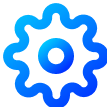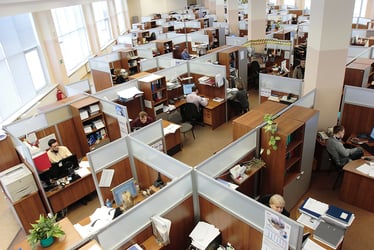
The current state of the business world, alongside many social factors, is giving rise to new terminologies, practices, and protocols in the workplace that may have existed previously, but for whatever reason, they've become more prevalent now. Work from home, remote technologies, and telecommuting opportunities, for instance, are some incredibly pressing concerns at the moment. Followed by contactless interactions, phased workplace re-entry, digital acceleration, and many more unique concepts.
It makes you think, how did we get here?
The reason why many of these new terms, phrases, and ideals are cropping up is that companies are being forced to respond, in real-time, to changes in the average workplace experience. What the modern workplace looks like now, is much different than how it looked even just a few months ago.
No one can say precisely how long this situation or these concepts will last. Even after things start to regain a little normalcy, the world is going to look much different. At least in the short-term, workplace experiences will need to be fluid, agile, and constantly changing. Your workplace strategies and business plans should be able to meet any fresh needs that arise, which means adapting whenever necessary.
The New Workplace Terminology
Here are just some of the new terms and concepts that you should become familiar with, if you're not already:
Things Affecting People/Employees
-
- Distributed Workforce Fewer workers are spending time inside company walls, and that trend will continue for a long while. Organizations must put measures in place to better manage, monitor, and communicate with their distributed workforce.
- Peak Occupancy The total capacity or occupancy levels that a property can take on. This number holds more meaning today, where social distancing is a huge factor.
- Remote Work Work experiences must be able to seamlessly move between on-site and off-site environments. Strategies for remote employee engagement should be considered.
- Telecommute Thanks to technology, it's now possible to work from anywhere, anytime. In some cases, modern workloads do have to be adapted to meet the needs of a virtual, distanced environment.
- Work Culture Preparing for the new, evolved workplace of tomorrow requires a systemic change across the entire organization that spans every purpose, every department, and every individual.
- Work from Home It's no longer about taking some work home at the end of the day, but instead about bringing the entire work environment into your residence. This is being achieved with the help of conferencing, cloud, and mobile technologies.
Emerging Technologies
-
- Contact Tracing In office contact tracing allows important departments to identify locations that have been contaminated so they can inform employees that had exposure to that space or other people within that space
- Contactless Interactions Social distancing helps, and it's still needed to maintain the safety and health of everyone. Therefore, contactless engagements will become the norm. They're low-touch, high-level interactions that help to bolster a more distanced corporate-customer relationship.
- Employee Density Monitoring Sensors placed in high traffic areas can provide actionable insights to how much of a space is being used to better configure allocation of people.
- Hoteling The process of reserving desks, offices, and entire spaces, in advance and via mobile or digital systems. This is going to help companies identify and plan for changing capacities in real-time.
- Mobile Authentication Secure digital or mobile-app-oriented interactions that allow users to identify and verify themselves. It's a secure way to interface with company locks and secure areas, make contactless payments, and much more.
- Mobility While mobile will play a huge factor moving forward, it's the versatility of the technology that truly empowers the world. Being able to dial in, work, and engage from anywhere in the world, at any time is a game-changer. At the same time, organizations must be able to deliver the kind of engaging and seamless mobile experiences that people desire.
- PropTech (Property Tech) Innovative, smart, and connected technologies designed to help manage, monitor, and facilitate the usage of company property, facilities, systems, and more.
- Remote Access Technologies that allow for distanced interactions, in whatever form that may be. It's not just about making virtual contact from dozens or even hundreds of miles away. Remote access can even be distanced access while still on company property.
- Sensors The smart sensors of today collect data in real-time and send it to where it's needed most. In the corporate world, many sensors will be used to manage and engage with those on a property, whether employees, customers, or partners.
- Spatial Visualization (Floorplans) Just like a directory, spatial visualization provides an overview of company properties or facilities. When merged with modern connected technologies, it can provide real-time data visualizations on visitor whereabouts, regular happenings, and more.
Workplace Strategies
-
- Built World The places and spaces within which we operate (and get work done) that are influenced by interdisciplinary sectors such as technology, architecture, landscape, civil engineering and more.
- Digital Acceleration The DA index helps companies determine digital maturity by uncovering strengths, weaknesses, and more. It also puts digital capabilities to the test in a more practical environment.
- Digital Transformation For years the enterprise world has been moving towards a digital landscape. Current events have catalyzed the need. Today's transformation will favor contactless, distanced and smart technologies.
- Digital Workplace The digital aspects of how we get work done and the technology environment that makes it possible.
- Location-Aware Devices such as beacons, geofencing systems, and wayfinding solutions will make it possible to analyze and understand how people are using a workplace and what that means for productivity.
- Low-Touch Environments Engaging, responsive, low-contact interactions that honor social distancing guidelines, while also injecting the "human feel" to most manual processes.
- Phased Re-Entry When it's time to return to work — and that time is fast-approaching — it will need to happen in a phased rollout. Varying departments and teams will need to return in instanced settings, to ensure work environments are adequately prepared.
- Real-time Communications With an increasingly dispersed workforce it is more important than ever to have instant, clear, and responsive communication solutions at hand.
- Return to Work Strategy Any strategy or process that expressly deals with the slow return to more traditional work environments. As more workers flock to the office, RtW strategies will be instrumental to a healthy, and safe reintegration.
- Smart Campus Workplaces of tomorrow must become digital-focused ecosystems, entire environments dedicated to the type of smart, connected experiences that employees want.
The Evolving Landscape
As current events, social factors, and consumer demands shape today's landscape, organizations are being forced to assess their workplace offerings, particularly when it comes to delivering an engaging employee experience. Many of the new phrases and terminologies you see here have become invaluable, at least way more than they ever have in the past.
The future of work is smart, connected, and innovative. Also, everything should map back to an environment that is fueled by technology, yet interlaced with different physical and digital touchpoints throughout the employee lifecycle.
It's time to learn them, make some changes of your own, or you may find your company left behind by the wheel of time.
See how we're building the workplace of the future! Get a demo of The Workplace SuperApp

.png)

.png)






